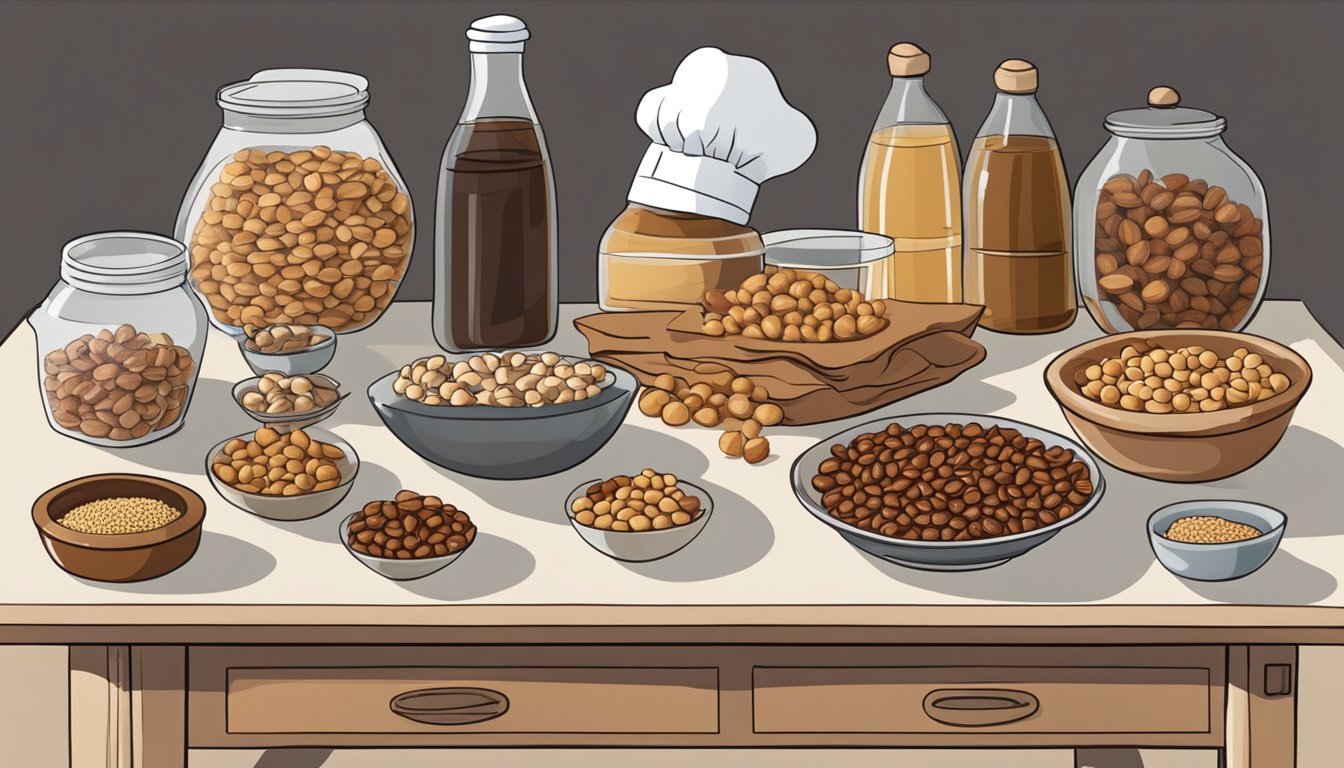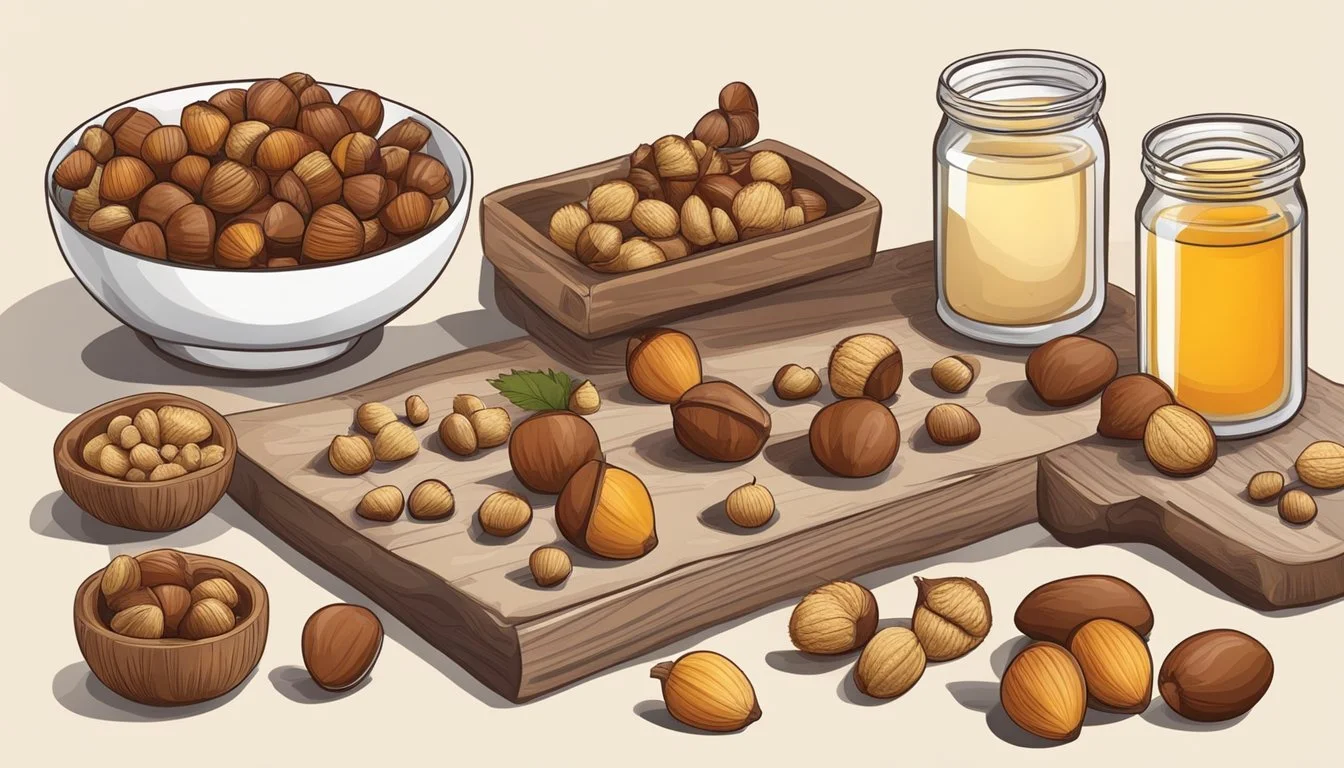Chestnut Substitutes
Top Alternatives for Cooking and Baking
Chestnuts, with their rich and sweet flavor, are a staple in various dishes ranging from savory stuffings to delectable desserts. They are highly sought after, particularly during the holiday seasons, for their unique taste and texture. However, due to factors such as seasonal availability or dietary restrictions, one may need to find suitable replacements that can mimic the characteristics of chestnuts.
Multiple alternatives exist for those looking to replicate the qualities of chestnuts in recipes. Substitutes such as sweet potatoes, pumpkin seeds, and other nuts like hazelnuts, pecans, and pistachios offer similar flavors and textures. These substitutes can be used in proportions that closely match that of chestnuts, ensuring that the end result maintains the integrity of the original dish. It is crucial to select the appropriate substitute based on the recipe's need for either a nutty flavor or starchy consistency.
Selecting chestnut substitutes requires a careful consideration of the recipe's flavor profile and textural outcome. For baked goods and stuffings, certain tree nuts like hazelnuts provide an earthy, nutty flavor similar to chestnuts and are widely available. In dishes that need a certain creaminess, pistachio nut spreads can be an excellent replacement, especially in cakes and breads. When a starchy quality is desired, alternatives like Japanese or purple sweet potatoes work well in purees and stuffings. Each substitute brings a distinct dimension to dishes, and adjusting the quantity used can help achieve a close match to the desired taste and structure that chestnuts typically provide.
Overview of Chestnuts
Chestnuts, the fruit of the chestnut tree (Castanea spp.), are notable for their rich, sweet flavor and are often associated with autumn and winter cuisines. Unlike most nuts, chestnuts have a high starch content and are low in fat, providing an energy boost reminiscent of staple carbohydrates.
Nutritional Profile: Chestnuts are packed with:
Fiber
Vitamin C
B Vitamins
Minerals such as potassium and magnesium
Chestnut trees are deciduous, with species native to many regions including Europe, Asia, and North America. They sport distinctive spiny capsules, or burs, that house the edible seeds.
Chestnut Blight: A significant threat to chestnut trees is the chestnut blight, a fungal disease caused by Cryphonectria parasitica. This pathogen can devastate chestnut populations, impacting the availability of these nuts.
Regarding nut allergies, chestnuts diverge from the more common culprits like peanuts and tree nuts. They contain different proteins, which means that individuals with nut allergies may not necessarily be allergic to chestnuts. However, one should always consult an allergist as chestnuts might still trigger reactions in some people with nut allergies.
In summary, chestnuts are a versatile and nutritious food source, but their availability can be affected by diseases such as chestnut blight. These nuts remain a traditional festive treat and are used in a variety of culinary applications, from sweet to savory dishes.
Health Benefits of Chestnuts
Chestnuts are a source of various nutritional benefits that contribute significantly to a healthy diet. They contain antioxidants, which help in protecting the body's cells from damage caused by free radicals. This protection is crucial as it may reduce the risk of chronic diseases and support overall health.
In terms of vitamins and minerals, chestnuts offer a substantial amount of vitamin C. Despite being a nut, chestnuts are atypical in their vitamin C content, more commonly found in citrus fruits. They are also rich in B-vitamins, especially B6, which is important for brain health and the creation of neurotransmitters.
Nutrient Benefit Dietary Fiber Promotes digestive health and can aid in maintaining a healthy weight. Potassium Essential for muscle function, nerve signals, and fluid balance. Manganese Plays a role in bone formation and blood clotting.
Chestnuts have fewer fatty acids compared to other nuts, however, the fats present are primarily unsaturated, which are considered heart-healthy. Additionally, dietary fiber is abundant in chestnuts; both soluble and insoluble fiber are present, aiding in digestion and offering a prolonged feeling of fullness, which can help with weight management.
In summary, chestnuts are nutrient-dense, offering a variety of essential elements that support bodily functions and contribute to overall well-being. Their unique nutritional profile makes them a valuable addition to a balanced diet.
Culinary Uses of Chestnuts
Chestnuts are versatile in the kitchen, featuring in various sweet and savory dishes due to their unique earthy flavor and slightly sweet taste. Their texture also allows them to be a staple ingredient in salads, providing a different mouthfeel and depth of flavor.
Sweet Recipes
In sweet recipes, chestnuts are often used as a primary ingredient or as a flavor enhancer. They can be found in the form of chestnut purée which is a key element in desserts like the classic Mont Blanc, a sweet that meshes the nut's rich flavor with creamy textures. Chestnuts can also be candied, known as marrons glacés, and used to decorate or add a burst of sweetness to cakes and pastries.
Examples of Sweet Recipes with Chestnuts:
Mont Blanc (Chestnut Cream Dessert)
Candied chestnuts (Marrons Glacés)
Chestnut cakes and tarts
Savory Recipes
Within savory recipes, chestnuts serve as a filling, a thickener, or a flavor component. Their starchy nature allows them to blend well with meats and other root vegetables. A classic use of chestnuts is in turkey stuffing, especially during festive seasons, where their subtle sweetness complements the savory taste of the meat. They also integrate well into vegetarian dishes (What wine goes well with vegetarian dishes?), offering a meaty texture without the use of animal products.
Examples of Savory Recipes with Chestnuts:
Turkey stuffing with chestnuts
Chestnut-based sauces for meats
Vegetarian patties with minced chestnuts
Salads
Chestnuts add a nutty crunch to salads when used either raw or toasted. They pair splendidly with leafy greens, offering a contrast in textures, and with their subdued sweetness, chestnuts can balance out the acidic dressings often found in salads. Additionally, they can serve as a protein substitute or textural element for those looking to add a new dimension to their salad recipes.
Salad Ingredients Compatible with Chestnuts:
Mixed greens (e.g., spinach, arugula)
Vinaigrette or citrus-based dressings
Roasted vegetables
Toasted seeds (e.g., pumpkin seeds) for added crunch
Common Chestnut Substitutes
When a recipe calls for chestnuts, various substitutes capture the nut's unique flavor and texture with options ranging from other nuts and seeds to non-nut alternatives.
Nuts and Seeds
Nuts and seeds offer the closest flavor and texture profile to chestnuts, making them excellent candidates for substitution in a variety of dishes.
Hazelnuts: They impart an earthy, rich flavor akin to chestnuts and work well in both sweet and savory recipes.
Pecans: With a buttery taste, pecans can mimic the creamy texture of chestnuts.
Almonds: Although slightly sweeter, almonds can replace chestnuts, particularly in baking.
Pistachios: Their distinct taste is suitable for dishes requiring a nutty flavor similar to chestnuts.
Pumpkin Seeds: As a robust and earthy seed, they can stand in for chestnuts, preferably in a toasted form.
Sunflower Seeds: A lighter option with a hint of sweetness, sunflower seeds are suitable substitutes in salads and baked items.
Nut-Free Alternatives
For those with nut allergies or dietary restrictions, several nut-free chestnut substitutes exist.
Jackfruit Seeds: Boiled or roasted, jackfruit seeds can provide a starchy texture reminiscent of chestnuts.
Water Chestnut: Water chestnuts bring a crunchy texture and mild flavor, suitable for savory applications.
Chestnut Flour Substitutes
If chestnut flour is unavailable, other nut and seed flours can serve as alternatives for gluten-free baking and cooking.
Almond Flour: A common substitute, almond flour's fine texture makes it ideal for pastries and cakes.
Hazelnut Flour: For a richer flavor, hazelnut flour can replace chestnut flour in most recipes.
Pecan Meal: Ground pecans can be used in place of chestnut flour, especially in pie crusts and cookies.
Taste and Texture Considerations
When seeking alternatives for chestnuts in recipes, one must consider the nutty flavor and crunchy texture that chestnuts provide. Chestnuts tend to have a mildly sweet and nutty flavor with a starchy, soft texture when cooked, which is unique compared to other nuts that typically have a harder consistency.
Walnuts: They impart a robust and earthy taste with a texture that adds complexity to dishes. Their flavor is stronger than that of chestnuts.
Pecans: Known for their buttery and slightly sweet profile, pecans offer a similar mouthfeel with a texture that can mimic the softness of chestnuts when cooked.
Hazelnuts: Provide a distinctly nutty flavor with a satisfying crunch. Although firmer, they can be toasted and ground to better approximate the texture of chestnuts.
Cashews: A softer nut that, when cooked, closely resembles the texture of chestnuts, with a creamy taste and a subtle sweetness.
Macadamia Nuts: These have a creamy texture and a subtle, buttery flavor that can effectively replace chestnuts in various recipes.
Sweet Potatoes: Not nuts, but their cooked texture can surprisingly approximate that of chestnuts. Their natural sweetness also mirrors the chestnut taste profile.
Here is a quick comparison table:
Substitute Flavor Profile Texture Walnuts Strong, earthy Less soft than chestnuts Pecans Buttery, sweet Soft when cooked Hazelnuts Nutty, slightly sweet Crunchy, but can be ground Cashews Creamy, sweet Similar to cooked chestnuts Macadamia Nuts Buttery, subtle Creamy Sweet Potatoes Sweet, starchy Soft, similar to cooked chestnuts
Choosing a substitute for chestnuts requires a balance between taste and texture to achieve a comparable culinary result. Each option provides a varying degree of nutty flavor and texture that can be leveraged according to the desired outcome in the recipe.
Special Dietary Requirements
When seeking chestnut substitutes, dietary restrictions guide the selection process. It's crucial to choose substitutes that align with one’s health needs and ethical choices.
Gluten-Free Options
Individuals on a gluten-free diet often need to be cautious about cross-contamination and hidden gluten sources. For those avoiding gluten, seeds and nut-based substitutes are generally safe. Pumpkin seeds and sunflower seeds are excellent gluten-free options that are versatile in various dishes, from salads to baked goods. They maintain a robust flavor profile similar to chestnuts and can be toasted for enhanced taste.
Pumpkin Seeds: Robust, earthy flavor, gluten-free.
Sunflower Seeds: Slightly sweet, gluten-free, can be toasted.
Vegan Choices
For vegans, the emphasis is on plant-based substitutes. Jackfruit seeds serve as a unique, nutritious vegan option that adds a meaty texture to dishes. They are derived from a fruit, ensuring that no animal products are involved. Tiger nuts, despite their name, are not nuts but tubers and are another vegan-friendly alternative rich in fiber and nutrients.
Jackfruit Seeds: Meaty texture, vegan, suitable for marinated dishes.
Tiger Nuts: Tubers, not nuts, high in fiber, potassium, and Vitamin E, vegan.
Each substitute brings its own nutritional profile, including varying levels of protein, fiber, and fat content. It's important for vegetarians and vegans to consider these aspects to meet their dietary needs.
Using Chestnut Substitutes in Recipes
When a recipe calls for chestnuts, but they are unavailable or someone is seeking an alternative, various substitutes can be used to replicate the flavor and texture of roasted or boiled chestnuts. Hazelnuts, for instance, offer an earthy, nutty flavor that can closely resemble that of chestnuts when used in homemade stuffing and other baked preparations.
Sweet potatoes are an excellent non-nut alternative, providing the starchy quality and sweetness akin to boiled chestnuts, particularly suitable for purées or stuffings. To use sweet potatoes as a replacement, one might consider mashing or dicing them into recipes.
Pumpkin seeds can add a robust depth to salads and baked goods. They should be measured out at three-quarters the specified amount of chestnuts in a recipe and toasted to enhance their flavor.
For a direct nut substitute, pistachios can fit well, especially in desserts like cakes or bread, where a pistachio spread might be used to mimic the creamy texture of chestnuts.
Here’s a quick guide on substituting chestnuts:
Substitute Measure (for 1 cup chestnuts) Best Used In Hazelnuts 1 cup, chopped Stuffing, Baked Goods Sweet Potatoes 1 cup, mashed/diced Purées, Stuffing Pumpkin Seeds 3/4 cup, toasted Salads, Baked Goods Pistachios 1 cup, ground/spread Cakes, Breads
When substituting, cooks should consider both the texture and flavor the ingredient will bring to the dish, as each substitute will impart its unique characteristics. Adjustments in the seasoning and preparation methods may be necessary to achieve a comparable result to the original chestnut-based recipe.
Selection and Storage of Substitutes
When selecting and storing chestnut substitutes, it's important to consider the form and shelf life of the alternative. Each type requires different storage methods to maintain freshness and flavor.
Shelf-Stable Substitutes
Shelf-stable substitutes like canned or jarred chestnuts and chestnut puree offer convenience and a longer shelf life. Here are some specifics:
Canned Chestnuts: Look for cans with no visible dents, rust, or bulging. Store unopened cans in a cool, dry place, away from extreme temperatures. Once opened, transfer unused chestnuts to an airtight container and refrigerate.
Storage Location Duration Unopened can Pantry Up to 1 year Opened can Refrigerator 3 to 5 days
Chestnut Puree: Choose jars that are intact and have a secure seal. Similar to canned chestnuts, store unopened jars in your pantry and refrigerated after opening.
Storage Location Duration Unopened jar Pantry Up to 1 year Opened jar Refrigerator up to 1 week
Fresh Alternatives
With fresh alternatives like sweet potatoes and hazelnuts, proper storage is key to maintaining their quality:
Sweet Potatoes: Select firm potatoes without soft spots. Store in a cool, dark place such as a basement or root cellar to extend shelf life.
Hazelnuts: These should be plump and free from cracks. Store in an airtight container in a cool, dry place. If bought in bulk, hazelnuts can also be kept in the refrigerator or freezer to retain freshness.
Substitute Storage Location Duration Sweet Potatoes Well-ventilated bin Cool, dark place Up to 1 month Hazelnuts Airtight container Pantry Up to 6 months Refrigerator Up to 1 year Freezer Up to 2 years
By adhering to these guidelines, one can ensure that their substitutes for chestnuts are stored correctly to maintain their quality until use.
Nutritional Comparison
When considering substitutes for chestnuts, it's important to take into account their nutritional profiles. Chestnuts are lower in calories and fats compared to most other nuts and offer a good amount of dietary fiber, Vitamin C, and copper.
Pumpkin seeds, offering a robust and earthy flavor, are high in magnesium and provide a decent amount of iron; however, they lack Vitamin C. To compare, sunflower seeds have significant Vitamin E and selenium but also do not supply Vitamin C.
Hazelnuts are a rich source of copper, critical for healthy blood vessels and immune function. They also provide a great deal of Vitamin E but fall short on Vitamin C. Almonds, similarly, are high in Vitamin E and have a favorable amount of copper, along with being a good source of fiber.
Pecans and walnuts stand out for their antioxidant properties and are an excellent source of copper. These nuts contain healthy monounsaturated fats but, like the others, do not provide Vitamin C.
Pistachios are noteworthy for their protein content and provide a decent dose of copper. However, the Vitamin C content is not significant. Brazil nuts, best known for their selenium content, are also an ample source of copper.
Sweet potatoes serve as a non-nut alternative, providing a variety of health benefits including fiber, potassium, and a modest amount of Vitamin C. They differ in macronutrient composition, being higher in carbohydrates and lower in fats.
It is evident that while substitutes can mimic the flavor and texture of chestnuts, they have varying nutritional profiles. None of the substitutes are particularly high in Vitamin C, a notable nutrient in chestnuts, but they contribute other health benefits including high levels of copper necessary for metabolic processes.
Allergies and Sensitivities
When considering chestnut substitutes, it's essential to keep in mind both nut allergies and sensitivities, as well as options that cater to these dietary restrictions. Here are the most pertinent details regarding alternative ingredients for individuals prone to these allergies.
Tree Nut Allergies
Tree nuts are among the top causes of food allergies. This category includes chestnuts, hazelnuts, pecans, almonds, and walnuts. Individuals with a tree nut allergy may experience a severe allergic reaction known as anaphylaxis upon exposure to these nuts. It's critical for them to avoid all tree nuts and products derived from them, even in trace amounts. While tiger nuts are often mentioned as a substitute, they are not actually nuts but tubers, making them generally safe for individuals with a nut allergy.
Seed Alternatives
In light of nut allergies, seeds can be a viable alternative. Seeds typically do not trigger nut allergies, although one must be cautious of cross-contamination during processing. Some seed options include:
Pumpkin seeds: Earthy in flavor; use 3/4 cup to replace a cup of chestnuts.
Sunflower seeds: They have a mild sweetness and can be toasted to enhance flavor.
It's crucial for those with allergies to verify that seeds are processed in a nut-free facility to prevent inadvertent exposure.
Innovative Substitutes
When seeking alternatives to chestnuts, one should consider not only nuts but also legumes and starchy vegetables that can mimic chestnuts' texture and flavor nuances.
Legume-Based Substitutes
Legumes offer a unique substitute for chestnuts due to their versatility and earthy flavor profile. Chickpeas in particular stand out as an excellent option. They possess a firm texture and nutty taste that can replicate the mouthfeel and savoriness of chestnuts, especially when roasted. Chickpeas can be pulsed into a coarse meal that, when toasted, brings a similar consistency and taste to dishes, making them suitable for recipes requiring chestnuts' texture.
Example:
Use roasted chickpeas as a topping in salads or soups for a crunch reminiscent of chestnuts.
Starchy Vegetables
The natural sweetness and soft texture of starchy vegetables offer a resemblance to the cooked form of chestnuts. Sweet potatoes and specifically purple sweet potatoes are commendable substitutes, providing a similar sweetness and creamy consistency. These vegetables can step in for chestnuts in a puree or when used as a filling or thickener in pastries and desserts.
Sweet Potato Equivalences:
Dish Type Sweet Potato Substitute Stuffings and Casseroles Cube and roast before using Purees and Mashes Boil or steam, then mash smoothly Desserts (Pies, Cakes, Pastries) Incorporate as a cooked puree
The use of sweet potatoes and purple sweet potatoes extends beyond savory dishes to sweet applications, showcasing their adaptive nature in the culinary world similar to chestnuts.
Conclusion
Selecting the right chestnut substitute can enhance a variety of recipes whether one is crafting a sweet dessert or a savory dish. Several nuts and seeds present viable options. Pecans, for instance, bring a buttery flavor and are native to North America. They prove to be a fine choice for a crunchy texture similar to chestnuts. Pumpkin and sunflower seeds, on the other hand, provide texture with an earthy robustness or a touch of sweetness respectively, particularly suitable for salads and baked goods when used in 3/4 the quantity of chestnuts.
It's also notable that pistachio nuts carry an earthy flavor compatible for stuffing or pureé applications. Sweet potatoes, especially the Japanese and purple varieties, can adeptly replace chestnuts in terms of sweetness and texture in stuffings or pureé recipes. Almond products such as flour or butter offer versatility; almond flour yields a parallel texture in baked goods, while almond butter introduces a nutty richness desirable for sauces or spreads.
Below is a summarized table of substitutes:
Substitute Characteristics Suggested Use Substitute Ratio Pecans Sweet, buttery General 1:1 Pumpkin seeds Robust, earthy Baked goods, salads 3/4 the amount Sunflower seeds Sweet Baked goods, salads 3/4 the amount Pistachios Earthy flavor Stuffing, pureés 1:1 Sweet Potatoes Sweet, dense Stuffing, pureés as needed Almond flour/butter Nutty, rich Baked goods, sauces as needed
Users should consider the desired end result of their dish when selecting their substitutes to ensure compatibility in terms of flavor, texture, and moisture content. In this way, one can still achieve the distinctive qualities that chestnuts impart to a recipe, even in their absence.













